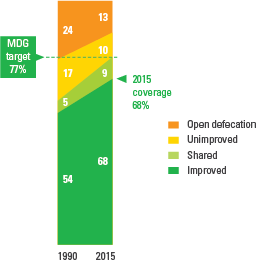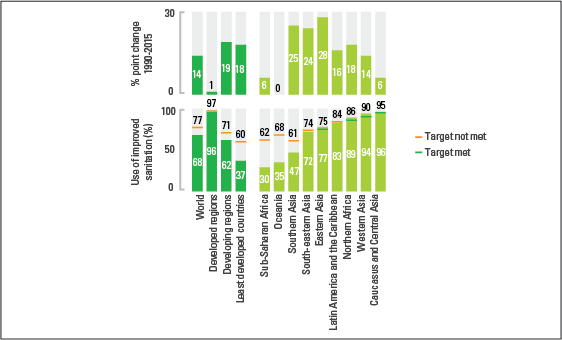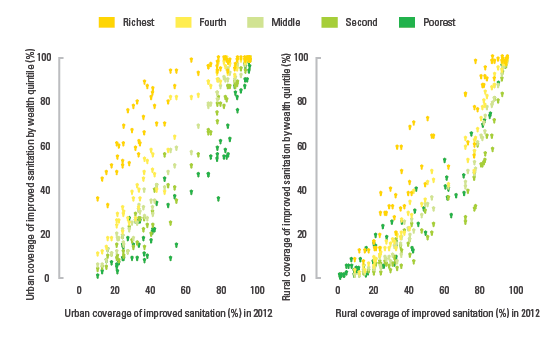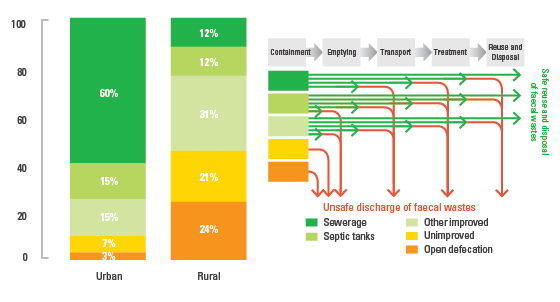Universal access to adequate sanitation is a fundamental need and human right. Securing access for all would go a long way in reducing illness and death, especially among children. Since 1990, 2.1 billion people have gained access to an ‘improved’ form of sanitation, such as flush toilets or latrine with a slab. This means that, in 2015, 68 per cent of the global population was using such facilities – an impressive accomplishment but still far from the 2015 Millennium Development Goal target, which has been missed by nearly 700 million people. In 2015, 2.4 billion people still lack an improved sanitation facility and among them almost 950 million people still practised open defecation. The data reveal pronounced disparities, with the poorest and those living in rural areas least likely to use an improved sanitation facility. Questions also remain about the full sanitation chain (containment, emptying, transport and treatment) and whether excreta are safely reused or returned to the environment.

Progress on Drinking Water and Sanitation - 2014 Report
The world has made great strides in increasing access to drinking water and sanitation for billions of people but progress has been uneven.
This joint WHO/UNICEF report documents the gains that have been made since 1990 and highlights substantive disparities such as those between regions, rural and urban areas and for marginalized groups.

JMP Website
WHO and UNICEF have monitored access to drinking water and sanitation through the Joint Monitoring Programme (JMP) for Water supply and Sanitation since the early 90s.
Progress on Sanitation and Drinking Water 2015 Assessement and MDG update
Looking back on 25 years of water, sanitation and hygiene monitoring, the report provides a comprehensive assessment of progress since 1990. The MDG target for drinking water was achieved in 2010 but the world has missed the sanitation target by almost 700 million people. In 2015, 663 million people still lack improved drinking water sources, 2.4 billion lack improved sanitation facilities and 946 million still practice open defecation.
JMP Progress on Sanitation and Drinking Water 2015 data dashboard
WHO/UNICEF JOINT MONITORING PROGRAMME FOR WATER SUPPLY AND SANITATION
Since 1990, WHO and UNICEF have tracked progress on global water and sanitation goals through the Joint Monitoring Programme for Water Supply and Sanitation (JMP). The JMP monitors trends in coverage; helps build national monitoring capacity in developing countries; develops and harmonises questionnaires, indicators and definitions to ensure comparability of data over time and among countries; and informs policymakers of the status of the water supply and sanitation sector through annual publications. The JMP draws guidance from a technical advisory group of leading experts in water supply, sanitation and hygiene, and from institutions involved in data collection and sector monitoring. Further information about the JMP and its methodology can be found at the JMP website.
DATA SOURCES
The JMP estimates for handwashing are based on information collected in household surveys such as Multiple Indicator Cluster Surveys (MICS) and Demographic and Health Surveys (DHS). Household surveys are usually conducted by national institutes of statistics, carried out by trained national staff who collect information on a wide range of health and living conditions through face-to-face interviews. Nationally owned and independently verifiable, these data sources provide national governments with a periodic update of the status and progress with respect to handwashing. Increasingly household survey data allow for assessing disparities in access by marginalized populations and geographic areas.
DEFINITION OF HANDWASHING FACILITIES WITH SOAP AND WATER
The presence of soap and water at a designated place is used a proxy for handwashing behaviours. Households are considered to have access if enumerators observe a place for handwashing and both water and soap are available.








